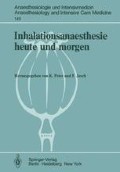Zusammenfassung
Seit der ersten Mitteilung von Vaisman [28] im Jahre 1967 über eine Häufung von Fehlgeburten bei Anaesthesistinnen, die vorwiegend Äthernarkosen durchgeführt hatten, wird den vermuteten Schadwirkungen durch die Langzeitexposition mit Spurendosen von Inhalations-anästhetika zunehmend Aufmerksamkeit geschenkt.
Access this chapter
Tax calculation will be finalised at checkout
Purchases are for personal use only
Preview
Unable to display preview. Download preview PDF.
Literatur
Askrog V, Harvald B (1970) Teratogen effect of inhalation anaesthetica. Saerty k Nord Med 3: 490–500
Baden JM, Brinkenhoff M, Whaxtons RS, et al. (1976) Mutagenicity of volatile anesthetics: halothane. Anesthesiology 45: 311–318
Bruce DL (1973) Murine fertility uneffected by traces of halothane. Anesthesiology 38: 473–477
Bruce DL, Bach MJ, Arbit J (1974) Trace anesthetic effects on perceptual, cognitive and motor skills. Anesthesiology 40: 453–458
Bruce DL, Bach MJ (1976) Effects of trace anesthetic gases on behavioral performance of volunteers. Brit J Anesth 48: 871–876
Coate WB, Kapp RW Jr, UUand BM, et al. (1979) Toxicity of low concentration long term exposure to an airborne mixture of nitrous oxide and halothane.
Cohen EN, Brown BW, Bruce DL, et al (1974) Occupational disease among operating room person¬nel A national study. Anesthesiology 41: 321–340
Cohen EN, Brown BW, Wu MJ, et al. (1980) Occupational disease in dentistry and chronic exposure to trace anesthetic gases. J Am Dent Assoc 101: 21
Corbett TH, Cornell RG, Enders JL, et al. (1973) Effects of low concentrations of N2 O on rat pregnancy. Anesthesiology 39: 299–301
Corbett TH, Cornell RG, Enders JL, et al. (1974) Birth defects among children of nurse-anesthetists. Anesthesiology 41: 341–344
Edmunds HN, Badden JM, Simmons VF (1979) Mutagenicity studies with volatile metabolites of halothane in man. Anesthesiology 51: 424–429
Ferstandig LL (1978) Trace concentrations of anesthetic gases: A critical review of their disease potential- Anesth Analg 57: 328 - 345
Fink BR, Shepard TH, Blandau RJ (1967) Teratogenic activity of nitrous oxide. Nature 214:146– 148
Fink BR, Cullen BF (1976) Anesthetic pollution: what is happening to us? Anesthesiology 45:79–83 79–83
Garro AJ, Phillips RA (1978) Mutagenicity of the halogenated olefin, 2-bromo-2-chloro-l, 1 difluoroethylene, a pressumed metabolite of the inhalation anesthetic halothane. Mutation Res 54: 17–22
Garro AJ, Phillips RA, Milliken RA, Leslie-Rendell-Baker (1979) Chronic Anesthetic Exposure - what is the margin of safety? Anesthesiology 50: 77–78
Garstka G, Wagner K-L, Hamacher M (1975) Schwangerschaftskomplikationen bei Anästhesistinnen. Geburtshilfe Frauenheilkd 35: 826–833
Knill-Jones RP, Mewman BJ, Spence AA (1975) Anaesthetic practice and pregnancy. Controlled survey of male anaesthetists in the United Kingdom. Lancet 2: 807–808
Lauven PM, Stoeckel HO (1981) Raumluftkonzentrationen der Inhalationsanästhetika im Opera-tionssaal unter Berücksichtigung von Schutzmaßnahmen. Anästh Intensivther Notfallmed 16: (im Druck)
Linde AW, Bruce DL (1969) Effects of chronic exposure of rats to traces of halothane. Proc IV. World Congr of Anesthesiologists London. Excerpta Medica Amsterdam, S. 923
Mazze R, Cascorbi H, Jones T, et al. (1981) Waste anesthetic gases in operating room air: A suggested program to reduce personnel exposure. ASA-Ad hoc committee of effects of trace anestheti agents on health of operating room personel
McGowan JC (1972) Effects of anaesthetics and related substances on the division of living cells. Lancet 2: 279–280
Michenfelder JD (1980) Editorial: Exposure to anesthetic gases and health problems in dental workers. Anesthesiology 53: 1–2
Nikki P, Pfäffli P, Ahlmann K, Ralli R (1972) Chronic exposure to anaesthetic gases in the operating theatre and recovery room. Ann Clin Res 4: 266–272
Sharp H, Trudell JR, Cohen EN (1979) Volatile metabolites and decomposition products of halothane. Anesthesiology 50: 2–8
Smith G, Shirley WA (1976) Failure to demonstrate effects of low concentrations of nitrous oxide and halothane on psychomotor performance. Br J Anaesth 48: 274
Spence AA, Cohen EN, Brown BW Jr, Knill-Jones RP, Himmelberger DU (1977) Occupation haz¬ards for operating roombased physicians. JAMA 238: 955–959
Vaisman AH (1967) Arbeitsbedingungen in den Operationsräumen und ihr Einfluß auf die Gesundheit der Anästhesiologen. Eksp Khir Anestheziol 3: 44
Walts LF, Forsythe AB, Moore JG (1975) Critique: occupational disease among operating room personnel. Anesthesiology 42: 608–611
Wharton RS, Mazze RJ, Baden JM, et al. (1978) Fertility, reproduction and postnatal survival in mice chronically exposed to halothane. Anesthesiology 48: 167–174
Editor information
Editors and Affiliations
Rights and permissions
Copyright information
© 1982 Springer-Verlag Berlin Heidelberg
About this chapter
Cite this chapter
Stoeckel, H.O., Lauven, P.M. (1982). Exposition gegen Spurenkonzentrationen flüchtiger Anaesthetika — Gegenwärtige Beurteilung. In: Peter, K., Jesch, F. (eds) Inhalationsanaesthesie heute und morgen. Anaesthesiologie und Intensivmedizin/Anaesthesiology and Intensive Care Medicine, vol 149. Springer, Berlin, Heidelberg. https://doi.org/10.1007/978-3-642-68712-9_4
Download citation
DOI: https://doi.org/10.1007/978-3-642-68712-9_4
Publisher Name: Springer, Berlin, Heidelberg
Print ISBN: 978-3-540-11756-8
Online ISBN: 978-3-642-68712-9
eBook Packages: Springer Book Archive

